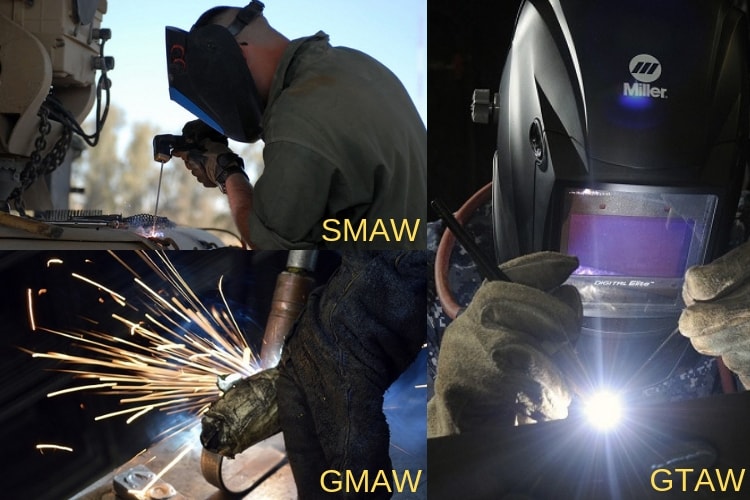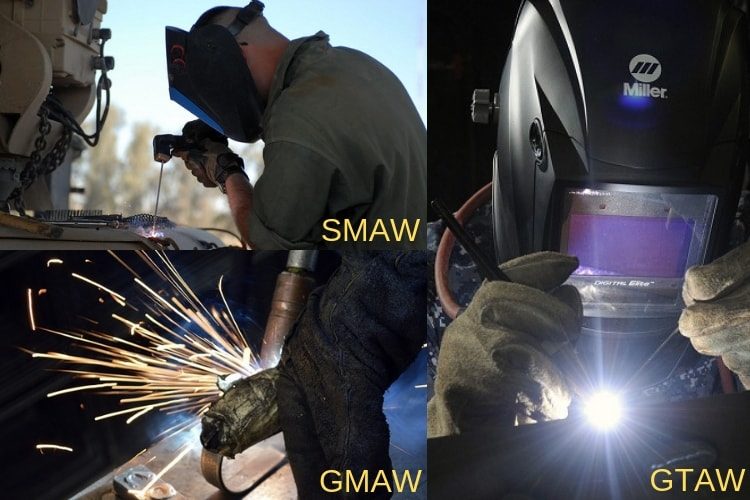Welding is one fast and reliable joining technique that has almost replaced other permanent joining processes. It can be defined as one joining process by which two or more materials can be assembled permanently with or without the applications of heat, pressure and filler. It can be overwhelmingly used for joining not only metals but also other types of materials including plastics and ceramics. To cater the need of joining a wide variety of materials in several ways, there exist large number of welding processes that can be broadly classified as fusion welding and solid state welding. A fusion welding is one where heat is applied externally to melt down faying surfaces of parent metal to form coalescence. Heat can be applied in various means such as by electric arc, gas flame, resistance heating, high energy beam, etc.
Accordingly, all arc welding, gas welding, resistance welding and intense energy beam welding processes fall within the envelop of fusion welding. In arc welding, an electric arc is constituted between a pointed electrode and the conductive base metals. This arc is the prime source of heat for melting faying surfaces and filler metals. There exist quite a few such processes—all of them follow the same basic principle but substantially vary with respect to procedure, benefits, limitations and feasible areas of application. Shielded metal arc welding (SMAW), gas metal arc welding (GMAW) and gas tungsten arc welding (GTAW) are three such arc welding processes—each of them offers certain advantages over others. Differences between SMAW, GMAW and GTAW welding processes are discussed below.

Consumable and non-consumable electrode: Electrode is integral to every arc welding process for establishing and maintaining electric arc. Such electrodes can be two types—consumable and non-consumable. A consumable electrode melts down during welding due to arc heating and subsequently deposits on weld bead that finally becomes an integral part of the joint. Contrary to this, a non-consumable electrode does not melt down during welding and remains intact. A particular arc welding process utilize only one type. With respect to consumable and non-consumable nature of electrode, comparison among SMAW, GMAW and GTAW welding processes is enlisted below.
- SMAW—Consumable electrode.
- GMAW—Consumable electrode.
- GTAW—Non-consumable electrode.
Application of filler metal: Filler metal is required to supply for filling up the root gap. When root gap is substantially larger (>2mm) and/or edge is prepared then filler should be applied. With consumable electrode, the electrode itself melts down and deposits on weld bead. Thus no additional filler is required to supply. Such electrode behaves as filler and feeding rate of electrode can be controlled to manipulate filler deposition rate. On the contrary, non-consumable electrode supplies no filler on weld bead. Thus if filler is required then it must be supplied separately.
- SMAW—No additional filler is required. Electrode acts as filler.
- GMAW—No additional filler is required. Electrode acts as filler.
- GTAW—Electrode is non-consumable. So additional filler in the form of small diameter rod is supplied, only when it is required, by constantly feeding it below the arc column.
Continuous nature of electrode/filler: The filler material, either in the form of electrode or a separate one, continuously melts down and deposits on weld bead. Thus its length gradually shortens with welding time. If this filler length is short then it has to be replaced frequently by a new one. This reduces rate of production and interrupts the process. On the other hand, a long filler can be continuously fed to the welding zone for longer duration without any interruption. Such method is productive but requires bulk storage of costly filler.
- SMAW—Filler-cum-electrode is in the form of small diameter straight rod of length 2 – 3ft. Thus it requires frequent changing and interruption of process.
- GMAW—Filler-cum-electrode is in the form of small diameter wire that is wound on a wire pool. Quite long wire electrode is stored in that pool and thus welding can be carried out continuously for longer duration without intermediate stoppage for electrode changing. This electrode is continuously fed by means of mechanized arrangements.
- GTAW—Electrode is non-consumable. Additional filler usually comes in the form of short, small diameter rod and thus requires frequent stoppage for changing the filler. However, welding can be carried out continuously if no filler is utilized.
Preferable welding mode: Arc welding can be performed in three different modes. As mentioned earlier, filler is not necessary to supply when root gap is very small or base materials are thin. When welding is carried out without applying any filler, it is termed as autogenous mode. However, if filler is applied and metallurgical composition of filler is similar to that of parent component, then it is termed as homogenous mode. If metallurgical composition of filler substantially differs from that of parent component, it is termed as heterogeneous mode. Different welding processes are suitable for different modes.
- SMAW—Filler is inherent to this process because of consumable electrode. So autogenous mode is not possible. It is suitable for mainly homogenous welding.
- GMAW—Similar to SMAW, filler is inherent to this process because of consumable electrode. So autogenous mode is not possible. It is suitable for homogenous and heterogeneous welding.
- GTAW—Electrode is non-consumable. So autogenous mode is feasible; in fact, TIG welding is suitable for this mode only. However, it can also be applied for homogenous and heterogeneous welding by utilizing optimum set of process parameters.
Electrode material: Electrode material of every arc welding process must possesses few basic characteristics like good electrically conductive, good electron emissivity, desired melting point, etc. It is worth mentioning that filler metal must be compatible with parent metal otherwise they will not mix up properly leading defective welding. Thus with consumable electrode, electrode material should be chosen based on compatibility with base metal. With non-consumable electrode, filler material should be chosen based on compatibility with base metal, whereas electrode should be made of such material with high melting.
- SMAW—Electrode is mostly made of ferrous materials. It has only few variety in terms of electrode material. Thus it is suitable for homogeneous joining of ferrous components only.
- GMAW—Wide variety of electrode materials are available in market. Although most electrodes are ferrous, their metallurgical composition can be varied to harness desired result.
- GTAW—This electrode is made of tungsten only. This is irrespective of base metal or filler metal as electrode is non-consumable. Tungsten has highest melting point (3422°C). Other desired properties can also be manipulated by adding alloying elements in small proportions. For example thorium, lanthanum oxide, cerium oxide, zirconia, etc. are added with tungsten for improving various welding characteristics like electron emissivity, electrode erosion, etc.
Coated or bare electrode: Electrode can be coated to protect it from oxidation or atmospheric contamination. Apart from protection against oxidation, coating also provides other advantages such as supplying shielding gas, reducing spatter, stabilizing arc, inducing chemical elements into weld bead, etc. However, a coated electrode is costly and prone to damage with time. Different processes utilize different types of coating, each having desired function.
- SMAW—Utilizes thick flux coated electrode. Apart from protecting the electrode, this flux supplies shielding gas.
- GMAW—No flux coating is available on electrode. However, a thin coating of stable material is applied to protect electrode material from oxidation.
- GTAW—Utilizes bare tungsten electrode. No coating is applied on electrode.
Shielding gas supply: Shielding gas is supplied in arc welding to dispense the oxygen from welding zone and create an envelope of inert gases surrounding the weld bead. Its primary function is to protect hot weld bead from oxidation. Such shielding gas can be supplied directly from a gas cylinder or indirectly by disintegrating other chemical elements during welding.
- SMAW—Flux coating of electrode disintegrates during welding and produces shielding gas. No separate shielding gas is applied separately.
- GMAW—Shielding gas (inert or active) is supplies from gas cylinder.
- GTAW—Inert shielding gas is supplied from gas cylinder.
Spatter problem: Spatter is small droplets of molten filer metal that is produced due to scattering of arc and comes out from the welding zone. This spatter causes loss of filler metal and thus non-uniform filler deposition rate that sometime leads to various welding defects including negative reinforcement and dimensional inaccuracy. It also hampers appearance and requires grinding after welding for its removal.
- SMAW—Produces excessive spatter even with optimum set of process parameters.
- GMAW—It also produces spatter; however, can be reduced by utilizing optimum set of process parameters.
- GTAW—It is mostly free from spatter.
Manual and automation: Shielded metal arc welding is carried out manually and thus it is also called manual metal arc welding (MMAW). Gas metal arc welding can be automated easily where electrode wire is continuously fed rom the spool using mechanised arrangement and at the same time torch is moved by another automatic vehicle. Gas tungsten arc welding is commonly performed manually; however, can be automated also, especially the movement of torch. An automated process is fast and more productive; but manual process is more flexible and virtually possess no restriction of location for its application.
Productivity and quality issues: SMAW does not offer good quality joint. Thus it is carried out mostly for household and general industrial requirements. Frequent changing of electrodes causes interruption in process and thus it is not suitable for longer welding requirement. GMAW is highly productive and can be carried out continuously for long duration. It can be automated easily. Its volume deposition rate is also very high. Thus it is suitable where wide root gap exists, edges are prepared in U or V shapes, longer joining requirements or even for cladding. Although it is less prone to defects, its joint quality is not very good. Spatter also hampers weld bead appearance. In terms of quality, GTAW is best among the three. It provides superior joint with splendid appearance. It is less prone to defects, but deposition rate or welding rate is comparatively low.
Scientific comparison among shielded metal arc welding (SMAW), gas metal arc welding (GMAW) and gas tungsten arc welding (GTAW) is presented in this article. The author also suggests you to go through the following references for better understanding of the topic.
- Gas Metal Arc Welding Handbook by W. H. Minnick (2007, Goodheart Willcox).
- Basic TIG & MIG Welding (GTAW & GMAW) by I. H. Griffin, E. M. Roden and C. W. Briggs (3rd edition, Delmar Cengage Learning).
- Shielded Metal Arc Welding by W. L. Ballis (2011, Xulon Press).


